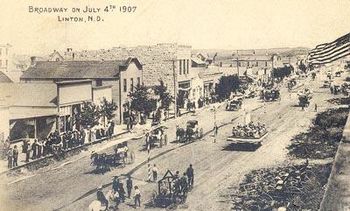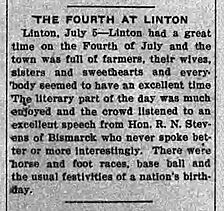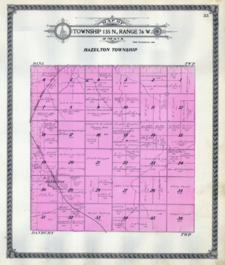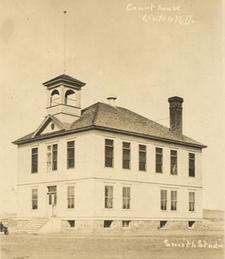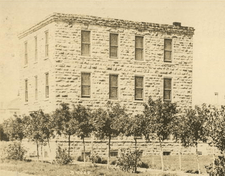Linton, North Dakota facts for kids
Quick facts for kids
Linton, North Dakota
|
|
|---|---|
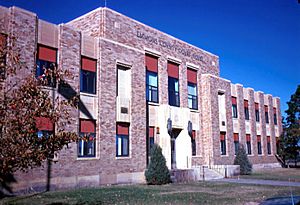
Emmons County Courthouse in Linton – Dedicated, October 6, 1934 on the occasion of the 50th anniversary of Emmons County
|
|

Location of Linton, North Dakota
|
|
| Country | United States |
| State | North Dakota |
| County | Emmons |
| Founded | 1899 |
| Area | |
| • Total | 0.79 sq mi (2.03 km2) |
| • Land | 0.79 sq mi (2.03 km2) |
| • Water | 0.00 sq mi (0.00 km2) |
| Elevation | 1,723 ft (525 m) |
| Population
(2020)
|
|
| • Total | 1,071 |
| • Estimate
(2022)
|
1,052 |
| • Density | 1,364.33/sq mi (526.84/km2) |
| Time zone | UTC-6 (Central (CST)) |
| • Summer (DST) | UTC-5 (CDT) |
| ZIP code |
58552
|
| Area code(s) | 701 |
| FIPS code | 38-46980 |
| GNIS feature ID | 1036132 |
| Highways | US 83, ND 13 |
Linton is a city in Emmons County, North Dakota, United States. It is the county seat, which means it's where the main government offices for the county are located. In 2020, about 1,071 people lived here. Linton is one of the larger cities in North Dakota for its size. It's an important center for government, shopping, and businesses in Emmons County.
A special historic place near Linton is the Sacred Heart Cemetery, Wrought-Iron Cross Site. It is listed on the National Register of Historic Places.
Contents
History of Linton
Linton was officially planned in August 1898. The goal was to create a new county seat for Emmons County. The land was carefully measured and divided into lots, streets, and alleys.
The town was named Linton after George W. Lynn. He was an early settler in Emmons County, arriving in 1885. Mr. Lynn was a farmer and a lawyer. He was also the first States Attorney for Emmons County. For a while, he published a local newspaper called the Emmons County Free Press.
Linton became an official village on April 26, 1906. Later, it became a full city on April 6, 1914. Charles Patterson was Linton's first postmaster. He started his job in March 1899.
In 1905, Linton got its first long-distance telephone connection. The Northwestern Telephone Exchange Company set up a line from Fargo to Bismarck. Then, a branch line was added to Linton. This allowed people in Linton to talk to others in Bismarck and beyond.
How Linton Became the County Seat
The creation of Linton was due to a disagreement in Emmons County. People in the northern part of the county and those in the southern part had different ideas. In 1885, the county seat was in Williamsport. This town was in the northern part of the county.
People in the southern half were unhappy because Williamsport was too far away. Also, most county leaders were from the north. The northern part had more people, which gave them more power in votes.
Eventually, people voted on whether to divide the county into two. If it passed, the north would stay Emmons County. The south would become Winona County, with Winona as its new county seat. However, the vote failed, and the county stayed as one.
The fight to move the county seat continued. Three more votes were held in the 1880s and 1890s. The first two failed. The third vote decided to move the county seat to the center of the county. This new central location became the city of Linton.
People in the north still wanted Williamsport to be the county seat. They claimed the election was unfair. They even got a court order to stop the move. Southerners were very upset by this. In January 1899, they went to Williamsport. They took the county records and moved them to the new county seat. They even took a very heavy safe, which is now in the Emmons County Museum.
No one was charged for taking the records. However, the Williamsport side managed to get the records back to their city. They also tried to force another election. This new election would have required a two-thirds vote for Linton to remain the county seat. But this election never happened.
The case went on in court for many months. Finally, the lawyer for Williamsport asked for the case to be dismissed. This meant Linton won! Linton has been the county seat of Emmons County ever since.
Because Williamsport lost its county seat status, it slowly disappeared. The Northern Pacific Railway also chose to build its line through Linton around 1897. Today, the area where Williamsport once stood is farmland.
The oldest newspaper in the community is The Emmons County Record. It started in Williamsport in 1884. Its founder, Darwin R. Streeter, moved it to Linton in 1899. The newspaper has been published continuously since then.
Notable People from Linton
Austin Anthony Vetter, a Roman Catholic bishop, was born in Linton.
Population Information
| Historical population | |||
|---|---|---|---|
| Census | Pop. | %± | |
| 1910 | 644 | — | |
| 1920 | 1,011 | 57.0% | |
| 1930 | 1,192 | 17.9% | |
| 1940 | 1,602 | 34.4% | |
| 1950 | 1,675 | 4.6% | |
| 1960 | 1,826 | 9.0% | |
| 1970 | 1,695 | −7.2% | |
| 1980 | 1,561 | −7.9% | |
| 1990 | 1,410 | −9.7% | |
| 2000 | 1,321 | −6.3% | |
| 2010 | 1,097 | −17.0% | |
| 2020 | 1,071 | −2.4% | |
| 2022 (est.) | 1,052 | −4.1% | |
| U.S. Decennial Census 2020 Census |
|||
Linton's Population in 2010
In 2010, Linton had 1,097 people living there. There were 557 households, which are groups of people living together. About 316 of these were families. Most of the people living in Linton were White.
About 18.5% of households had children under 18. Many households (49.9%) were married couples. About 40.9% of all households were single people living alone. Also, 23.2% of households had someone aged 65 or older living by themselves.
The average age in Linton was 54 years old. About 17.7% of residents were under 18. A large portion, 32.7%, were 65 years or older. The city had slightly more females (52.5%) than males (47.5%).
Education in Linton
Linton is part of the Linton Public School District 36. This district manages the schools in the area.
Early Pictures of Linton
Geography and Climate
Linton is located at specific coordinates: 46°16′6″N 100°13′56″W / 46.26833°N 100.23222°W. You can also find Linton by looking for where US Highway 83 and ND Highway 13 cross.
The city covers a total area of about 0.75 square miles (2.0 square kilometers). All of this area is land.
Linton has a type of climate called a warm-summer humid continental climate. This means it has warm summers and cold, snowy winters.
| Climate data for Linton, North Dakota, 1991–2020 normals, extremes 1917–2008 | |||||||||||||
|---|---|---|---|---|---|---|---|---|---|---|---|---|---|
| Month | Jan | Feb | Mar | Apr | May | Jun | Jul | Aug | Sep | Oct | Nov | Dec | Year |
| Record high °F (°C) | 62 (17) |
67 (19) |
86 (30) |
96 (36) |
108 (42) |
110 (43) |
116 (47) |
110 (43) |
106 (41) |
94 (34) |
78 (26) |
69 (21) |
116 (47) |
| Mean maximum °F (°C) | 44.3 (6.8) |
49.2 (9.6) |
63.7 (17.6) |
80.8 (27.1) |
89.3 (31.8) |
94.4 (34.7) |
100.1 (37.8) |
99.9 (37.7) |
94.1 (34.5) |
82.7 (28.2) |
62.7 (17.1) |
49.0 (9.4) |
102.2 (39.0) |
| Mean daily maximum °F (°C) | 22.0 (−5.6) |
27.3 (−2.6) |
40.1 (4.5) |
55.9 (13.3) |
68.9 (20.5) |
78.1 (25.6) |
84.5 (29.2) |
83.5 (28.6) |
73.3 (22.9) |
56.7 (13.7) |
40.5 (4.7) |
27.6 (−2.4) |
54.9 (12.7) |
| Daily mean °F (°C) | 11.4 (−11.4) |
16.3 (−8.7) |
29.4 (−1.4) |
42.6 (5.9) |
56.1 (13.4) |
66.4 (19.1) |
71.8 (22.1) |
69.9 (21.1) |
59.8 (15.4) |
44.7 (7.1) |
29.5 (−1.4) |
17.5 (−8.1) |
42.9 (6.1) |
| Mean daily minimum °F (°C) | 0.7 (−17.4) |
5.2 (−14.9) |
18.7 (−7.4) |
29.4 (−1.4) |
43.3 (6.3) |
54.7 (12.6) |
59.1 (15.1) |
56.4 (13.6) |
46.4 (8.0) |
32.6 (0.3) |
18.6 (−7.4) |
7.4 (−13.7) |
31.0 (−0.5) |
| Mean minimum °F (°C) | −28.7 (−33.7) |
−23.2 (−30.7) |
−9.1 (−22.8) |
12.2 (−11.0) |
23.8 (−4.6) |
36.6 (2.6) |
43.0 (6.1) |
39.2 (4.0) |
25.0 (−3.9) |
12.2 (−11.0) |
−4.1 (−20.1) |
−20.7 (−29.3) |
−31.4 (−35.2) |
| Record low °F (°C) | −44 (−42) |
−52 (−47) |
−32 (−36) |
−12 (−24) |
12 (−11) |
25 (−4) |
30 (−1) |
26 (−3) |
11 (−12) |
−10 (−23) |
−31 (−35) |
−42 (−41) |
−52 (−47) |
| Average precipitation inches (mm) | 0.46 (12) |
0.39 (9.9) |
0.35 (8.9) |
0.99 (25) |
2.49 (63) |
3.09 (78) |
2.85 (72) |
1.57 (40) |
1.25 (32) |
1.86 (47) |
0.42 (11) |
0.58 (15) |
16.30 (414) |
| Average snowfall inches (cm) | 8.9 (23) |
6.4 (16) |
3.4 (8.6) |
2.7 (6.9) |
0.5 (1.3) |
0.0 (0.0) |
0.0 (0.0) |
0.0 (0.0) |
trace | 1.6 (4.1) |
6.9 (18) |
3.7 (9.4) |
34.1 (87.3) |
| Average precipitation days (≥ 0.01 in) | 3.3 | 3.1 | 3.5 | 4.9 | 9.2 | 9.7 | 6.7 | 6.7 | 4.5 | 4.4 | 2.4 | 2.8 | 61.2 |
| Average snowy days (≥ 0.1 in) | 3.6 | 3.1 | 2.4 | 0.8 | 0.1 | 0.0 | 0.0 | 0.0 | 0.0 | 0.3 | 1.9 | 2.9 | 15.1 |
| Source 1: NOAA | |||||||||||||
| Source 2: National Weather Service (mean maxima and minima, average precip/snow 1917–2008, precip/snow days 1981–2010) | |||||||||||||
See also
 In Spanish: Linton (Dakota del Norte) para niños
In Spanish: Linton (Dakota del Norte) para niños


